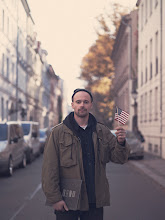Come see what all the fuss is about at the opening reception for Philip Perkis' The Sadness Of Men, Thursday Feb. 28, 6-8pm @ Alan Klotz Gallery, 511 W. 25th St, NYC.



Back in my art school days (and above is what I could find of it..) when I would put pictures up on the wall in Phil's class he often gave me the same homework for the following week. Looking back this was perhaps some of the best feedback I received at school and it appears as Exercise #4 Intention in his book Teaching Photography:
"Go anywhere to photograph in your usual way. For one roll, every time you take a picture, turn around and quickly take a second picture of whatever you see that is in back of you.
----------
Many years ago, the painter Raymond Parker wrote an essay on the idea of intention in art-making. As I remember it, his basic thesis was that without intention there can be no art. Makes sense. If I want to build Chartres Cathedral or make a dramatic film then it is clear that my intention must precede the execution of these projects. At every point of building a structure or making a film, decsions are made both large and small, conscious and unconscious, that significantly affect the result. It still remains that there was a "plan" needed first and that plan is an expression of intent.
Let's go a different way. I set up an arena where something can take place. Then I see what happens. John Cage did this in music and called it 'Chance Operations.' People who play improvisational music do this all the time. There have been many experiments in theater and performance art that have been based on this idea.
Spalding Gray did a show called Interviewing the Audience around 1980. It was a brilliant example of setting a stage and then improvising within the boundaries.
As a photographer, I decide on a certain set of materials (camera, lens, film) and I take myself somewhere at a certain time. It could be my backyard or living room; it doesn't have to be Outer Mongolia. Then I'm going to see what happens. I become an active responder to what is happening both inside and outside of myself. I do my best not to consider content or meaning at this time. Then, putting myself in that position physically, emotionally and mentally, I can have an 'open' attitude toward what I am doing so that with a bit of luck (grace) my intention can arise simultaneously with the act of photographing.
Alfred Hitchcock said that he never considered content when making a film. He just concentrated on moving the story along.
This attitude is no less intentional than planning ahead. If anything, it can be more intentional because it involves more of me in the activity. In a sense, I'm turning some of the responsibility over to my instinct, impulse and receptivity, and taking a little heat off my mind, which just might let it function better than when it has to carry the whole weight of the job.
It should be pointed out that in photography I don't print everything I shoot. In fact, I print very, very little. This lets me take enormous risks when I photograph. My intention can be re-formed in editing. My emphasizing certain aspects of tone when I print, I can reinforce intention. So, in a way, I have three chances.
I once sat breathless for about 20 minutes at the Brooklyn Academy of Music with about 1,500 other people while Julius Hemple stood alone on stage playing improvisationally on a tenor saxophone. That's high risk art-making. His intentionality was palpable. He had no cover."
2/28/08
Intention
Labels: photographers
